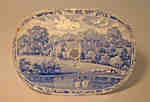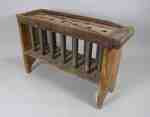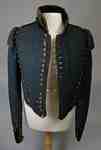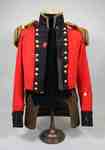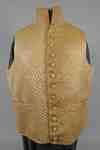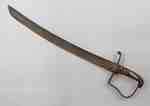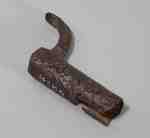Results
We found 1449 matching items.




- Margaret Stewart Sewing Sampler, 1811
 A sampler sewn by Margaret Stewart in 1811. The sampler measures 38cm x 90cm, and there is a dark green trim around the outside. The lettering on the sampler reads "Learning will stand you friend when riches fail and happy are those that attain it". The sampler is also inscribed …
A sampler sewn by Margaret Stewart in 1811. The sampler measures 38cm x 90cm, and there is a dark green trim around the outside. The lettering on the sampler reads "Learning will stand you friend when riches fail and happy are those that attain it". The sampler is also inscribed …  A sampler sewn by Margaret Stewart in 1811. The sampler measures 38cm x 90cm, and there is a dark green trim around the outside. The lettering on the sampler reads …
A sampler sewn by Margaret Stewart in 1811. The sampler measures 38cm x 90cm, and there is a dark green trim around the outside. The lettering on the sampler reads … - Blue and White China Platter- Catharine Currie
 This china platter features a blue and white estate scene and a decorative border. It is flat and oval shaped. This platter comes from the Catherine Currie Estate.
This china platter features a blue and white estate scene and a decorative border. It is flat and oval shaped. This platter comes from the Catherine Currie Estate.  This china platter features a blue and white estate scene and a decorative border. It is flat and oval shaped. This platter comes from the Catherine Currie Estate.
This china platter features a blue and white estate scene and a decorative border. It is flat and oval shaped. This platter comes from the Catherine Currie Estate. - Candle Mold
 This candle mold is made of both wood and pewter. There are eighteen pewter casings, set in a wooden-framed box, supported by two metal rods. There is also a loop across the top of the mold to tie wicks onto while the candles are setting. Candles would have been an …
This candle mold is made of both wood and pewter. There are eighteen pewter casings, set in a wooden-framed box, supported by two metal rods. There is also a loop across the top of the mold to tie wicks onto while the candles are setting. Candles would have been an …  This candle mold is made of both wood and pewter. There are eighteen pewter casings, set in a wooden-framed box, supported by two metal rods. There is also a loop …
This candle mold is made of both wood and pewter. There are eighteen pewter casings, set in a wooden-framed box, supported by two metal rods. There is also a loop … - Candle Lantern
 This candle lantern is painted black and is a cylindrical shape. It has a perforated slit and circle design with a cone shaped top and handle. There is also a door on the side that opens to where the candle is located. It is unsure whether this lantern was used …
This candle lantern is painted black and is a cylindrical shape. It has a perforated slit and circle design with a cone shaped top and handle. There is also a door on the side that opens to where the candle is located. It is unsure whether this lantern was used …  This candle lantern is painted black and is a cylindrical shape. It has a perforated slit and circle design with a cone shaped top and handle. There is also a …
This candle lantern is painted black and is a cylindrical shape. It has a perforated slit and circle design with a cone shaped top and handle. There is also a … - Glengarry Light Infantry Fencibles Junior Officer Coatee Believed to have Belonged to Donald McDougald- 1795-1830

 This is a wool and velvet coatee that is believed to be designed for a Glengarry Militia Officer, but the date of origin is unknown. It is a single breasted green coat with a velvet trimmed stand up collar and cuffs. There are also three rows of buttons down the …
This is a wool and velvet coatee that is believed to be designed for a Glengarry Militia Officer, but the date of origin is unknown. It is a single breasted green coat with a velvet trimmed stand up collar and cuffs. There are also three rows of buttons down the … 
 This is a wool and velvet coatee that is believed to be designed for a Glengarry Militia Officer, but the date of origin is unknown. It is a single breasted …
This is a wool and velvet coatee that is believed to be designed for a Glengarry Militia Officer, but the date of origin is unknown. It is a single breasted … - Uniform Coat Worn by Captain MacMicking of the 1st Regiment of the Lincoln Militia: 1810-1820
 This uniform coat was worn by Captain MacMicking of the Lincoln Militia, 1st Regiment. The double breasted coat is red brushed wool broadcloth with black lace on the dark blue wool lapels, collar and cuffs. There is a stand up collar "Skirt" at the back, one epaulet on the right …
This uniform coat was worn by Captain MacMicking of the Lincoln Militia, 1st Regiment. The double breasted coat is red brushed wool broadcloth with black lace on the dark blue wool lapels, collar and cuffs. There is a stand up collar "Skirt" at the back, one epaulet on the right …  This uniform coat was worn by Captain MacMicking of the Lincoln Militia, 1st Regiment. The double breasted coat is red brushed wool broadcloth with black lace on the dark blue …
This uniform coat was worn by Captain MacMicking of the Lincoln Militia, 1st Regiment. The double breasted coat is red brushed wool broadcloth with black lace on the dark blue … - Uniform Coat Belonging to Colonel Aeneas Shaw of the 1st Regiment of the Lincoln Militia- c.1810-1820

 This uniform coat belonged to Colonel Aeneas Shaw of the 1st Regiment of the Lincoln Militia during the War of 1812. It is believed to be a staff officer uniform and has five pairs of buttons down the front with the “GR” cipher of the British Militia. This wool coat …
This uniform coat belonged to Colonel Aeneas Shaw of the 1st Regiment of the Lincoln Militia during the War of 1812. It is believed to be a staff officer uniform and has five pairs of buttons down the front with the “GR” cipher of the British Militia. This wool coat … 
 This uniform coat belonged to Colonel Aeneas Shaw of the 1st Regiment of the Lincoln Militia during the War of 1812. It is believed to be a staff officer uniform …
This uniform coat belonged to Colonel Aeneas Shaw of the 1st Regiment of the Lincoln Militia during the War of 1812. It is believed to be a staff officer uniform … - Single White Glove- c. 1806-1812
 This single gloves was fashioned from white tulle and carefully embroidered. It is in the long sleeve style and shows what women of 1812 would have worn.
This single gloves was fashioned from white tulle and carefully embroidered. It is in the long sleeve style and shows what women of 1812 would have worn.  This single gloves was fashioned from white tulle and carefully embroidered. It is in the long sleeve style and shows what women of 1812 would have worn.
This single gloves was fashioned from white tulle and carefully embroidered. It is in the long sleeve style and shows what women of 1812 would have worn. - Blue Silk Bodice- c. 1810
 This silk bodice was likely part of an evening dress and may have had a matching skirt. The fabric is from an earlier time period and was most likely remade from an 18th century dress. The bodice features blue and white stitched flowers and gives insight into women's wear in …
This silk bodice was likely part of an evening dress and may have had a matching skirt. The fabric is from an earlier time period and was most likely remade from an 18th century dress. The bodice features blue and white stitched flowers and gives insight into women's wear in …  This silk bodice was likely part of an evening dress and may have had a matching skirt. The fabric is from an earlier time period and was most likely remade …
This silk bodice was likely part of an evening dress and may have had a matching skirt. The fabric is from an earlier time period and was most likely remade … - British Uniform Coatee Worn by Colonel Daniel McDougal- 1812
 This uniform coatee was worn by Colonel Daniel McDougal when he was an Ensign at the Battle of Lundy’s Lane on July 25, 1814. The design is for a Junior officer (ensign or lieutenant) of the Volunteer Incorporated Militia Battalion. It is double breasted with an open stand up collar …
This uniform coatee was worn by Colonel Daniel McDougal when he was an Ensign at the Battle of Lundy’s Lane on July 25, 1814. The design is for a Junior officer (ensign or lieutenant) of the Volunteer Incorporated Militia Battalion. It is double breasted with an open stand up collar …  This uniform coatee was worn by Colonel Daniel McDougal when he was an Ensign at the Battle of Lundy’s Lane on July 25, 1814. The design is for a Junior …
This uniform coatee was worn by Colonel Daniel McDougal when he was an Ensign at the Battle of Lundy’s Lane on July 25, 1814. The design is for a Junior … - Silk and Wool Neck Scarf- c.1800
 This scarf was fashioned out of silk and wool and features a green and rose floral pattern on a cream background and a tassle fringe around the edges. The scarf is thought to have belonged to Mrs. Secord Cartwright.
This scarf was fashioned out of silk and wool and features a green and rose floral pattern on a cream background and a tassle fringe around the edges. The scarf is thought to have belonged to Mrs. Secord Cartwright.  This scarf was fashioned out of silk and wool and features a green and rose floral pattern on a cream background and a tassle fringe around the edges. The scarf …
This scarf was fashioned out of silk and wool and features a green and rose floral pattern on a cream background and a tassle fringe around the edges. The scarf … - British Officer’s Waistcoat Once Belonging to Alonzo Strong
 Part of the Servos Collection, and is listed as a British Officer’s waistcoat once belonging to Alonzo Strong of St. Ann's Ontario. It is more likely that it is a domestic waistcoat. There are eleven self-covered buttons, a cross pattern and quilted in curved lines. Ecru silk waistcoat, chain stitch …
Part of the Servos Collection, and is listed as a British Officer’s waistcoat once belonging to Alonzo Strong of St. Ann's Ontario. It is more likely that it is a domestic waistcoat. There are eleven self-covered buttons, a cross pattern and quilted in curved lines. Ecru silk waistcoat, chain stitch …  Part of the Servos Collection, and is listed as a British Officer’s waistcoat once belonging to Alonzo Strong of St. Ann's Ontario. It is more likely that it is a …
Part of the Servos Collection, and is listed as a British Officer’s waistcoat once belonging to Alonzo Strong of St. Ann's Ontario. It is more likely that it is a … - Colonial Union Jack Flag

 This cotton flag features a colonial Union Jack design and a stamp that reads "War of 1812". Although the flag is hand-stitched, it is not clear whether the flag was used during the War of 1812 or not, or if it was only ceremonial.
This cotton flag features a colonial Union Jack design and a stamp that reads "War of 1812". Although the flag is hand-stitched, it is not clear whether the flag was used during the War of 1812 or not, or if it was only ceremonial. 
 This cotton flag features a colonial Union Jack design and a stamp that reads "War of 1812". Although the flag is hand-stitched, it is not clear whether the flag was …
This cotton flag features a colonial Union Jack design and a stamp that reads "War of 1812". Although the flag is hand-stitched, it is not clear whether the flag was … - Indian Chief Musket and Ramrod
 This musket, circa1812, with its ramrod attached, is a flintlock converted to a percussion steel firing mechanism. The barrel is steel and the stock is made of walnut. The marks include: the Hanoverian crown, the “GR” cipher, “London” and “R & K Sutherland” or "R & R Sutherland" on the …
This musket, circa1812, with its ramrod attached, is a flintlock converted to a percussion steel firing mechanism. The barrel is steel and the stock is made of walnut. The marks include: the Hanoverian crown, the “GR” cipher, “London” and “R & K Sutherland” or "R & R Sutherland" on the …  This musket, circa1812, with its ramrod attached, is a flintlock converted to a percussion steel firing mechanism. The barrel is steel and the stock is made of walnut. The marks …
This musket, circa1812, with its ramrod attached, is a flintlock converted to a percussion steel firing mechanism. The barrel is steel and the stock is made of walnut. The marks … - Sabre- c. 1812
 A steel sabre, with a wooden grip, that is cavalry issue dated during the War of 1812. It was found on the banks of the Niagara river.
A steel sabre, with a wooden grip, that is cavalry issue dated during the War of 1812. It was found on the banks of the Niagara river.  A steel sabre, with a wooden grip, that is cavalry issue dated during the War of 1812. It was found on the banks of the Niagara river.
A steel sabre, with a wooden grip, that is cavalry issue dated during the War of 1812. It was found on the banks of the Niagara river. - Musket Ball

 Original donated and identified as a clay musket ball with a circumference of 5cm. It is highly doubtful that such an item would ever be used effectively as a musket ball and is more likely a marble or other such item.
Original donated and identified as a clay musket ball with a circumference of 5cm. It is highly doubtful that such an item would ever be used effectively as a musket ball and is more likely a marble or other such item. 
 Original donated and identified as a clay musket ball with a circumference of 5cm. It is highly doubtful that such an item would ever be used effectively as a musket …
Original donated and identified as a clay musket ball with a circumference of 5cm. It is highly doubtful that such an item would ever be used effectively as a musket … - Sword and Scabbard Owned by Captain Daniel Servos- 1778
 This is an officer’s sword that has the inscription “Capt’n Daniel Servos, Butler’s Rangers 1778” on its scabbard. The hilt is silver and green with an eagle on the pommel. The sword was donated to the Museum by William Kirby, who married into the Servos family. Servos is said to …
This is an officer’s sword that has the inscription “Capt’n Daniel Servos, Butler’s Rangers 1778” on its scabbard. The hilt is silver and green with an eagle on the pommel. The sword was donated to the Museum by William Kirby, who married into the Servos family. Servos is said to …  This is an officer’s sword that has the inscription “Capt’n Daniel Servos, Butler’s Rangers 1778” on its scabbard. The hilt is silver and green with an eagle on the pommel. …
This is an officer’s sword that has the inscription “Capt’n Daniel Servos, Butler’s Rangers 1778” on its scabbard. The hilt is silver and green with an eagle on the pommel. … - Bar Shot
 This bar shot was found at the mouth of the Niagara River and is believed to be British. It is two solid cast iron balls connected by a bar to form a shape of a “dumbbell”. Bar shots were cannon weaponry used by the Navy to destroy a ship’s sails.
This bar shot was found at the mouth of the Niagara River and is believed to be British. It is two solid cast iron balls connected by a bar to form a shape of a “dumbbell”. Bar shots were cannon weaponry used by the Navy to destroy a ship’s sails.  This bar shot was found at the mouth of the Niagara River and is believed to be British. It is two solid cast iron balls connected by a bar to …
This bar shot was found at the mouth of the Niagara River and is believed to be British. It is two solid cast iron balls connected by a bar to … - Blockhouses at Fort George- Wall Fragment
 This is a fragment from one of the original Blockhouses located at Fort George. The date associated with this fragment is 1792. However, Fort George was originally completed in 1802. Therefore, it can not be from the time recorded.
This is a fragment from one of the original Blockhouses located at Fort George. The date associated with this fragment is 1792. However, Fort George was originally completed in 1802. Therefore, it can not be from the time recorded.  This is a fragment from one of the original Blockhouses located at Fort George. The date associated with this fragment is 1792. However, Fort George was originally completed in 1802. …
This is a fragment from one of the original Blockhouses located at Fort George. The date associated with this fragment is 1792. However, Fort George was originally completed in 1802. … - Bayonet Socket

 This is a bayonet socket with a small portion of the blade attached that was discovered in the Niagara River. A bayonet is a steel blade that is designed to fit on the muzzle of a rifle or musket barrel, making it into a close range weapon. This would have …
This is a bayonet socket with a small portion of the blade attached that was discovered in the Niagara River. A bayonet is a steel blade that is designed to fit on the muzzle of a rifle or musket barrel, making it into a close range weapon. This would have … 
 This is a bayonet socket with a small portion of the blade attached that was discovered in the Niagara River. A bayonet is a steel blade that is designed to …
This is a bayonet socket with a small portion of the blade attached that was discovered in the Niagara River. A bayonet is a steel blade that is designed to …


